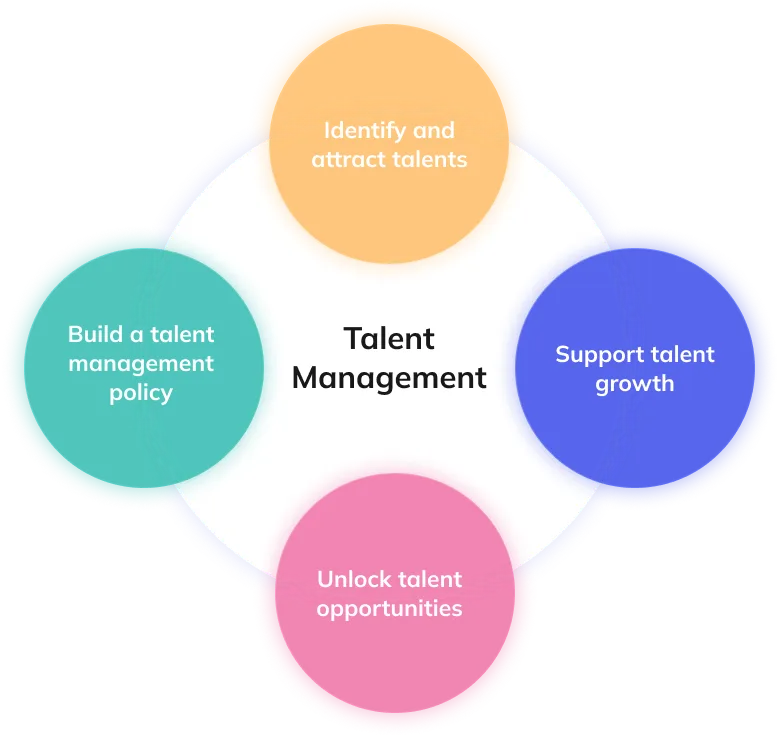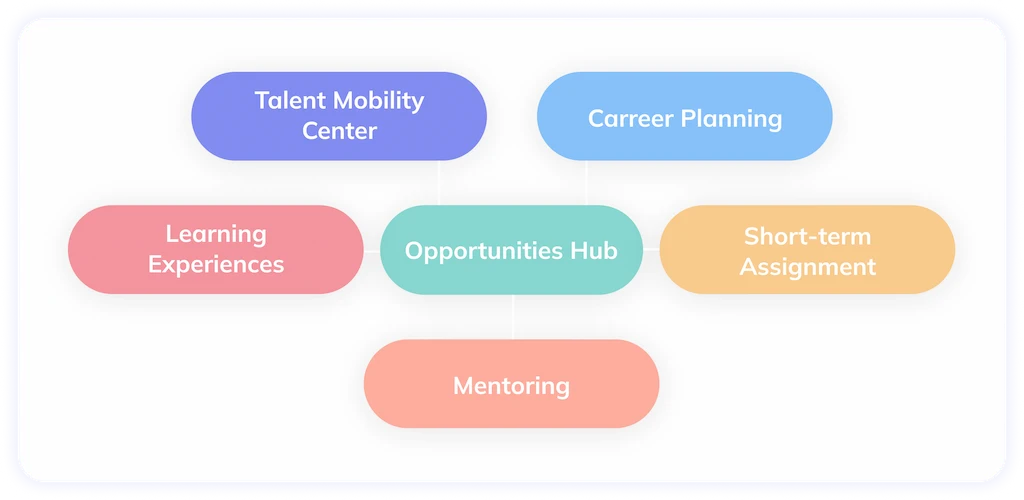Recipes from Talent Management
Managing talent development has become the latest mission for HR teams. Best practices for invigorating a company’s workforce have grown exponentially, from acquiring to retaining talent. We’re excited to share our insights on this vast and important topic.

The notion of “talent” appeared in 1990, against a backdrop of growing competitive pressure. The term was seen as an asset that set successful companies apart from the rest.
Formalized by McKinsey in its book “The War for Talent“, the spread of an HR mindset known as “talent management” significantly boosts a company’s performance through the systematic detection and development of talented employees.
Why is there such an interest in talent management?
This craze comes from an adaptation of HR practices to various evolutions. Previously , this discipline was essentially focused on the“Succession Plan“, the use of high potential matrices.
Today, talent management is keeping pace with organizational and sociological transformations. Career paths are becoming more diversified, with individuals changing jobs between 5 and 15 times, and no longer obey the aspirational responses of the old hierarchical organizational models. As a result, talent management needs to find a new lease of life in order to address a growing number of employees, whether managers, experts or individual contributors.
Talent management is no longer simply a matter of planning for tomorrow’s leaders, but of taking advantage of the best HR practices to meet today’s challenges of a company open to its ecosystem. Carole Menguy, explains one of these best practices in the B Smart program: the galaxie des métiers offer, which gives employees a taste for internal change and re-motivates them.
Building a talent management policy
How should we view the term “talent” today?
This term no longer refers to a marginal fringe, to be considered exclusively within the population:
- According to ANDRH, 52% of talent management is now considered to be aimed at all employees (up from 44% in 2017). The disengagement of employees favors a more “inclusive” vision of talent where it’s the company’s responsibility to create the conditions for the fulfillment of each of the company’s vital forces.
- Luc Bretones, NextGen CEO, mentions curiosity and agility as common denominators for this population. Indeed, 28% of employees have successfully taken on new roles in 2021. Now, 69% of the most attractive companies prioritize these qualities over a reputable career path or a solid degree when recruiting: the importance of continuous learning skills is becoming prevalent.
Talent is characterized by know-how and interpersonal skills that are particularly well suited to a business context. Even if the definition of a talent differs from company to company, one major fact suggests that certain qualities are common to today’s talents.
What is the definition of talent management today?
Talent management is seen as a process aimed at maximizing the potential of all the company’s employees. This practice is conditioned by the company’s culture, and in particular its willingness to encourage collaborative learning and ensure that everyone benefits from collective knowledge.
Talent management is historically made up of 4 stages that we develop in our page “What are the challenges of talent management“:
- Identify the necessary talent.
- Attract and integrate these new employees from outside or inside the company.
- Develop their skills according to the needs of the company.
- Engage them in a lasting way through a variety of means depending on the individual.
To help you build your talent management policy, you will find the following diagram showing the factors to be taken into consideration:
- Influencing factors: depending on the company’s key business strategy, what will be the skills future and how can culture be an obstacle or facilitator?
- The levers for achieving objectives : these are essentially managerial and digital with the notions of “change” and HRIS tools
- Expected results: from the different types of performance (organizational, economic, social …), to your power of attractiveness and resilience to face the permanent changes.
Talent management practices are rooted in three simultaneous logics:
- A logic of evaluation of skills enriched by individual aspirations and contribution to collective issues. This calls into question the classic performance review.
- A logic of individualization of trajectories made possible by the combination of access to knowledge through technology and individual responsibility.
- A pragmatic and actionable planning logic for skills in the near future. The Strategic Worforce Planning approach responds to the need for collaboration between HR, business and finance and to the orchestration of business transformation in the face of new business challenges.
Dr.John Sullivan, an expert in HR planning, points out the damage created by years of lack of planning at skills . Growing uncertainties also require rooting tactical thinking in a 6-month horizon to support the necessary agility. A balance must be found between the current model of long-term resource planning, which is often outdated after 18 months, and more immediate management.
Responding to talent development requires a system of engagement and support that blends into the company’s culture. How can we move from an employee management model to a dynamic mobilization of talent?
Our People Management and Talent Management: What are the differences?” page addresses this issue.
The obstacles to the development of inclusive talent management in France
A first cultural brake
The emergence of “People & Talent Director” or “Talent & Development Expert” functions should not mask the fact that the elitist vision is still at the top of current talent management models. In other words, a policy arbitrated at group level, coordinated by HR mainly by means of annual interviews, which is struggling to spread into everyday managerial behavior.
The difficulty of fighting multiple battles drives talent management policy in three main aspects:
- The guarantee of having “top managers” by identifying high potentials
- The construction of succession scenarios for key individuals in the event of departure or mobility
- A more recent field: accompanying managers in transformations, synonymous with coaching, upskilling or complete reskilling.
A second economic brake
The second barrier is the slowdown in talent management projects caused by the crisis, whether it’s attracting external talent, managing talent through continuous training or leadership programs, or even holding talent reviews… The lack of budget, personnel and time (devoting 10 to 25% of one’s time to HR management is already a victory on one’s agenda) adds to the cultural barrier. However, this investment quickly pays off in terms of its positive impact on talent acquisition and, above all, retention.
A third digital brake
Here are 3 major facts about HR digitization:
- 34% of companies with more than 300 employees are equipped with a Talent Management platform.
- A strong disparity remains between companies with 300 to 1000 employees, 31% of which have these solutions, and companies with more than 10,000 employees, with an equipment rate of 62%.
- Excel is still a persistent reality, even within large organizations where 1 in 6 tool their talent management with Excel.
The value of digital solutions to the profession is twofold:
- Benefit from an integrated tool: skills Performance, development needs, annual appraisal and mobility form a homogeneous whole.
- Individualize the support of talents thanks to the use of reliable and exploitable data without reprocessing.
You can go more in depth on the subject of software solutions thanks to our page “HRIS, from administrative management to the skills marketplace“.
Promote talent management culture
What are the real expectations of the talent?
A historical movement is taking place today: on the one hand, employees are questioning their deep relationship to work, and on the other, companies are re-evaluating their understanding of the notion of talent. These reflections are leading to numerous studies and surveys that give employees a voice. The motivations are often contradictory, telework would have a negative effect on life balance and isolation, even though it has been strongly claimed for several years. Behind these questions, we believe that the notion of trust is the common denominator for the conditions of fulfillment and performance.
Earning that trust relies on 3 variables:
- The authenticity of the managerial relationship
- Fairness in the consideration of everyone according to their preferences
- Transparency in communication, listening and real implementation of commitments
A talent, despite its protean expectations, demands above all that its company offers it the conditions for acquiring the knowledge to develop in a unique way. In fact, according to a study by the MIT Sloan Management Review, 2020, only 41% of them are confident that their skills is sustainable. We consider these skills futures in our Page “What skills value in business?”
Seizing the opportunity of external talent: the advantages of freelancers
Is the growing scarcity of talent also due to the increase in the number of freelancers? These external talents, whose number is now estimated at more than one million(+145% in 10 years), represent a “pollination” opportunity thanks to the specific skills they have. The richness of their views and experiences is a lever for the progress of internal talents and the organization as a whole.
Responding to the need for development can be nourished by challenges and projects: let’s take inspiration from the freelancers’ modus operandi to stimulate a new culture of talent development on board. The Webinar in which our CEO, Paul Courtaud, talks with Pentalog is enlightening: take a close look.
Renewing the methods for identifying the talent pool
Rely on a talent mapping solution
The talent pool is a term commonly used to refer to the most promising candidates within recruiting firms. There are two types of solutions for building this talent pool for companies that want to mobilize their talent:
– Candidate Relationship Management. They are used to communicate with external talent during the recruitment process or to maintain their interest in internal opportunities.
– Talent Management solutions. They are able to reveal and map all of the skills talents, anticipate the skills of the future while associating individual development skills.
Artificial intelligence is often highlighted for its ability to make visible information that has been ignored until now, to suggest recommendations to support HR decisions. This technology is currently evolving on the ethical and performance dimensions that we invite you to read in our page “AI for Talent Management“.
Rethinking the talent assessment and detection process
For French HR managers, annual interviews remain the primary tool for evaluating and identifying talent, ahead of the talent review and the professional interview. However, this process does not enjoy the support of employees and their managers. Revealing potential and aspirations and assessing performance do not exclude annual interviews or in-depth talent reviews. We discuss this in our article “organizing an effective talent review“.
Talent management tools: the opportunity offered by talent marketplaces
What is a Talent Marketplace?
A talent marketplace is a platform designed to facilitate the expression of aspirations and skills talents with internal opportunities, whether in the form of new roles or one-off assignments. With the emergence of these solutions, the days when mobility paths were dedicated solely to the company’s “high potentials” are over. They are in line with the new management methods we describe in our Organization centered on skills” page.
Equipped with an artificial intelligence foundation, the new talent management space addresses the major trends of the“Future of Work:
- To offer a tailor-made path to talents by creating a link between their aspirations for development, diversification of experience and various internal opportunities.
- Identify, gather and mobilize skills around a common issue, build internal teams quickly to carry out projects for which managers are responsible.
A vast majority (90%) of managers told HBR that these platforms are of paramount importance to their future competitiveness. Integrating this philosophy into the daily life of HR actors requires mapping aspirations and skills upstream in order to match individual desires with the options actually available, and thus contribute to mobility that makes sense for everyone.
Talent Marketplaces: the new face of talent management
The decompartmentalization of talent movements
Companies often put in place rules that compartmentalize the movement of talent: need for a certain level of seniority, to be on the list of top potentials, to have the approval of the manager.
We detail this innovation in our Complete Guide: “Internal Talent Marketplace“.
The answer to talent shortages
The persistent difficulties of recruitment(57.9% of the 3 million annual recruitments are considered to be complicated, according to the BMO study) call for a rethinking of the design of each position to be filled. John Boudreau, Senior Research Scientist and Professor Emeritus at University of Southern California, talks about the opportunity to rethink a job into tasks and distribute them differently throughout the organization. McLean & Company estimates a 120% performance gain for companies that manage to redeploy their internal resources rapidly.
The gas pedal of diversity and collaboration
Thinking in terms of projects is an opportunity to mix various profiles that do not usually evolve together around two criteria: skill and the desire to contribute to a common issue that gives meaning to the work.
Internal talent mobility platforms are also an opportunity to disseminate know-how across the company. For example, an individual can apply for a training course recommended or taken by a colleague. The collaborative dimension of the talent marketplace makes traditional procedures evolve towards behaviors that are more in line with the participative logic of recent generations of talent.
Future prospects for Talent Marketplaces
The obstacles to be removed to democratize talent marketplaces
The current context of permanent uncertainty gives a strong legitimacy to these platforms. This is what Deloitte emphasizes in its report, with the consultancy firm highlighting the need to match resource redeployment objectives with aspirations for projects that are most meaningful to employees.
However, there are still cultural barriers to overcome in the sharing of talent between managers in different departments. Temporary internal mobility can also be perceived as a risk in the eyes of employees who wonder whether they will be able to keep their job after taking up the opportunity.
The Promise of Total Workforce Management Systems
As we have seen, the use of freelancers is growing for reasons of cost and flexibility. The question now arises of how to manage both categories of talent, freelancers and permanent staff, simultaneously by two different parties: the HR function and the purchasing function.Total workforce management systems offer the possibility of centralizing these resources to guide them in their allocation according to priorities, but also in the traditional processes of on-boarding, evaluation, knowledge transfer, etc.
Retain and develop talent
Redefining the employee-company relationship
The relationship between the company and its employees has evolved, leading to a rebalancing of requirements towards the latter. Salaried employment no longer offers job security or guaranteed career advancement; it has become a service to be transformed.
Most companies have responded to the new demands of talent with an emphasis on quality of working life and benevolent management. While these initiatives are certainly commendable, they can overlook the very essence of work, its content and meaning. New pillars need to be reinvented in response to talent’s deep-rooted expectations:
- An HR system that is conducive to concrete, personalized support, which gives visibility to each individual aspiration.
- An authentic and mobilizing social commitment that is part of an evolving culture; fostering commitment means first and foremost respecting one’s commitments.
- Fair, adult-to-adult management that empowers talent, values the quality of its work and its successes.
Talent Management and High Potentials
Differentiating between talent and high potential
These two populations are often equated, even though they are different. Talents evolve in all positions in the company, while high potentials are executives destined for the highest responsibilities because they have the appetite for it. Consequently, “talent” is synonymous with excellence, whereas “high potential” implies an elitist vision.
A high potential has certain unchangeable characteristics:
- Geographic and functional flexibility
- Easy to learn
- A capacity to apprehend a high level of complexity
- A willingness to assume managerial responsibility
The desire to manage is becoming increasingly rare, with 20% of today’s managers declaring that they no longer want to manage. This is why we need to redefine and upgrade the role. The move into management is often attributed to contributors who perform well in their expertise, whereas its original vocation is to contribute to the development of skills. Selecting employees who truly aspire to be inspiring leaders, and providing them with the necessary training, is an often overlooked performance lever.
There is little theory on detection and support programs for high potentials. Our projects with major French industrial companies lead us to recommend the following 5-step methodology:
- Define the skills behavioral requirements to drive the company’s forward-looking vision (integrated into your skills repository).
- Evaluate these skills on an initial cohort of employees.
- Identify recurring patterns. That is, similar tendencies from one individual to another.
- Carry out cross-cutting pathway discovery programs with different levels of responsibility.
- Objectivize high potentials each year thanks to the correlation of career paths and behavioral levels skills .
The management of high potentials is one of the concerns of many companies, we discuss in detail its good practices in our page “The keys to the management of high potentials”.
Talent management and succession planning
How to explain this figure on managerial succession?
Lack of confidence in HR recommendations? An awareness of their lack of support in the face of increasing complexity? Fear of a lack of alignment of the new generation’s managerial convictions with the old one to faithfully succeed them?
Does this distrust serve succession plans?
Succession planning is not just for executives, but is part of the workforce planning process, where forecasting headcount, skills and their costs provides increased visibility.
The “Succession Plan” aims to provide continuity of key functions to implement the company’s strategy in its essential activities and skills strategic. This exercise is conditioned by the flattening of the strategy and the knowledge of the internal skills .
Managing your human capital with a starting point of skills is the core of Neobrain’s expertise. Read our point of view on our “Mapping of skills” page.
Planning the implementation of successions invites thinking about the timeframes in order to pass on the skills. We note 2 major ideas that are key success factors observed from our clients:
- Anticipation of individual and collective impacts on the company’s organization chart.
- Taking into account individual aspirations in order to envisage sustainable trajectories
Is succession planning a current topic in your company? Find all our advice in our “Talent Management and Succession Planning” page.
The talent management policy modifies the traditional HR approach by its grip on the present time and by taking into account the preferences of employees.
Complementary question
How can the dissemination of organizational and societal performance be carried out simultaneously when the day-to-day activities of the company’s players are focused on financial and economic performance?
FAQ
- How do you differentiate between talent management and people management?Talent management is a more proactive and strategic approach than employee management, which remains a more administrative activity. Traditionally, identifying employees with exceptional potential and helping them develop has been the domain of talent management. However, today’s shortage of skills is driving organizations to extend talent management best practices to a broader population.
- How to retain talent and build long-term loyalty?Each talent has specific expectations. However, certain pillars are common: offering career development prospects, stimulating assignments, a favorable work environment, competitive compensation, regular recognition and a positive corporate culture. The managerial approach is also changing, what support do you provide for the various changes? Our Guide, built with several HRDs, provides guidelines to follow: The benevolent HRD Guide.
- How to anticipate managerial succession and ensure the company's sustainability?To anticipate management succession, it is important to identify high-potential talent and prepare them for leadership roles. This can be done by offering them management assignments, specific training, coaching and mentoring. It is also important to encourage the transmission of knowledge and skills key skills between generations.
- What technology tools can help companies manage their talent?There are many technological tools available today to manage talent, such as talent management software skills, talent marketplaces, performance evaluation tools, and online training systems. The most important thing is not to have this tool but to choose it according to its adequacy with your culture, the desired ergonomics and to foresee the evolutions and its capacity to integrate with the current tools. Thinking about users is our job: here is the White Paper dedicated to this subject.
Do you still have questions ?
Please feel free to contact us for more information 😃













